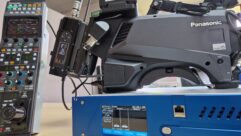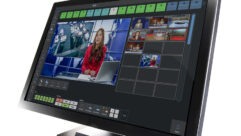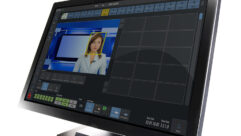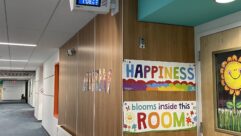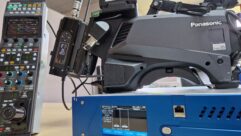
School District Invests in Robotic Camera Control
Dec 17, 2008 12:00 PM,
By Linda Seid Frembes

Charlie Happ, chief engineer for the Montgomery County Public Schools Instructional TV (MCPS ITV) in Rockville, Md., with the Shotoku TG-18 pan-tilt head.
There is a new emphasis on increasing productivity in today’s economy, but that concept isn’t new to folks like Charles Happ, chief engineer for the Montgomery County Public Schools Instructional TV (MCPS ITV) in Rockville, Md. “Our strategy is to do as much as we can with one person,” he says.
Happ, who has been with the organization for the past 15 years, is one of three full-time staff members on the engineering team. He and his team do installations and research for new equipment for the busy studio, which broadcasts 32 hours of school, community, and purchased programming per day on two local Comcast channels that are available to 220,000 homes and all 200 schools in Montgomery County.
To further the studio’s productivity, MCPS ITV recently installed a Shotoku Broadcast Systems remote-controlled camera system. Based in Japan, Shotoku manufactures both robotic and manual support camera equipment. It supplied a 2-channel pan-and-tilt head configuration with a TR-8S control panel and Learn Mode option to streamline studio operations and maximize resources.
The remote-controlled system means that a production person can now accomplish triple the results. “The technical director can switch the show and also control two of the three studio cameras,” Happ says. “We can have one person in the studio to operate the teleprompter, a manually operated wide-shot camera, and perform stage manager duties.”
Happ says that the studio also produces a number of talk shows, and recent technology upgrades have enabled them to go from six people in the studio down to just four people. “It gets more people out of the studio and working on other projects like field shoots and editing,” he says.
Shotoku’s Learn Mode is a feature that allows an operator to teach the pan-and-tilt heads a complete series of movements that can be reproduced exactly. “We can teach it specific macros to execute at the push of a button, which also saves us time and personnel,” Happ says.
MCPS ITV installed the system in October with help from Shotoku. According to the company, the configuration is comprised of two TG-18 pan-and-tilt heads controlled by a TR-8S control panel. The TG-18 heads, known for their reliability for live performances, incorporate high-resolution encoders for accurate and repeatable positioning. The TR-8S control system, capable of controlling numerous cameras and storing 900 shots per camera, features a LCD display that shows the status of all cameras under its control as well as detailed information of the selected camera. Additionally, the Shotoku system also interfaces with the studio’s Ross Synergy 1 production switcher tally system so operators know which camera is in service, eliminating the possibility of its being moved accidentally while on the air.
1
School District Invests in Robotic Camera Control
Dec 17, 2008 12:00 PM,
By Linda Seid Frembes

Happ operates the Shotoku TR-8S control panel while John Brittain and Bob Gierszewski look on.
The studio’s student interns also played a factor in equipment choice. The system’s manual override was a huge selling point. Using this feature, students can use the studio camera’s pan handles in manual mode, or the staff members can operate them robotically.
“The system is accomplishing all our goals,” Happ said in a recent press release. “With possible budget cuts, it will prove its value by allowing personnel to double and triple their responsibilities. We were even able to save money by using our original lenses and cameras. Shotoku retrofitted the lenses with several servo motors so they now have motorized zoom and focus functions that we didn’t have before.”
Recently, the studio has also purchased Sony PMW-EX1 compact full HD cameras so that one person can shoot in the field. “The camera works well in low light, so there is less need of an extra person to do the lighting,” Happ says.
The studio currently covers Board of Education meetings and produces TV programs such as The Math Dude, a video series for students enrolled in Algebra 1, and Homework Hotline Live!, a show that gives students an opportunity to call on-air teachers for help with their homework.
2


